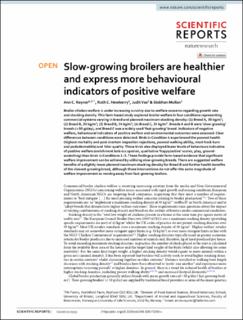| dc.description.abstract | Broiler chicken welfare is under increasing scrutiny due to welfare concerns regarding growth rate and stocking density. This farm-based study explored broiler welfare in four conditions representing commercial systems varying in breed and planned maximum stocking density: (1) Breed A, 30 kg/m2; (2) Breed B, 30 kg/m2; (3) Breed B, 34 kg/m2; (4) Breed C, 34 kg/m2. Breeds A and B were ‘slow-growing’ breeds (< 50 g/day), and Breed C was a widely used ‘fast-growing’ breed. Indicators of negative welfare, behavioural indicators of positive welfare and environmental outcomes were assessed. Clear differences between conditions were detected. Birds in Condition 4 experienced the poorest health (highest mortality and post-mortem inspection rejections, poorest walking ability, most hock burn and pododermatitis) and litter quality. These birds also displayed lower levels of behaviours indicative of positive welfare (enrichment bale occupation, qualitative ‘happy/active’ scores, play, ground-scratching) than birds in Conditions 1–3. These findings provide farm-based evidence that significant welfare improvement can be achieved by utilising slow-growing breeds. There are suggested welfare benefits of a slightly lower planned maximum stocking density for Breed B and further health benefits of the slowest-growing breed, although these interventions do not offer the same magnitude of welfare improvement as moving away from fast-growing broilers. | en_US |

